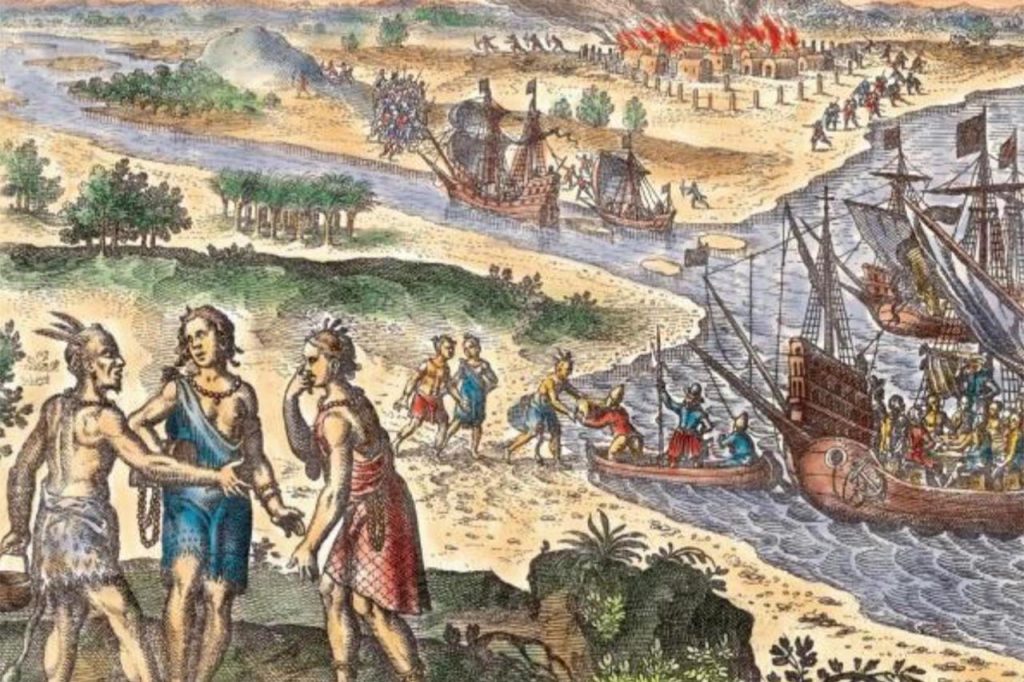
Thomas Wotton
Thomas Wotton (1585-1669) (Lawrence ancestor) was a surgeon who came to Jamestown in 1607 with the first group of settlers, and he is the earliest of the Townsend family to arrive in the New World. “Thomas Wotton, a doctor, was born in England 1585, died in Virginia 1669. Came to Jamestown, VA as physician with Capt. John Smith, 1607 (see “Relation of Virginia” by Capt. John Smith, Smith’s History, 1624).
In “Republic of America,” by Alexander Brown, p. 28: Dr. Thomas Wootton, Gentleman, is given as one of Capt. Smith’s exploring expedition which left Jamestown May 31, 1607. He is evidently the first doctor of medicine in America and is believed to be the son of Sheriff Wotton of Kent.
Another surgeon, Will Wilkinson, who was also among the first colonists. Wotton was described as a “gentleman” while Wilkinson was identified with the laborers and craftsmen. Captain John Smith praised Wilkinson for his treatment of the sick. Edward Maria Wingfield, when council president, on the other hand, criticized Wilkinson for staying aboard ship during periods of great need. Wingfield would not provide funds for Wilkinson to purchase drugs and other necessities because of his view of Wilkinson’s slothfulness.
Captain Christopher Newport who brought the first settlers from England, took Wotton on his journey up the James River on the Susan Constant to the falls at Richmond, Virginia before the Captain returned to England for supplies. Wotton stayed to help care for the colonists.
Thomas settled in Isle of Wight County, Virginia where he married widow Sarah Wood and died there in 1669. His will was proved March 16, 1669. It mentions wife Sarah, son Richard and wife’s son, Thomas Wood.
William Spencer
William Spencer, (1576-1664) (Townsend – Harvey ancestor), was an early Virginia colonist on Jamestown Island, who was an ancient planter and a member of the Virginia House of Burgesses in Jamestown, Virginia for Mulberry Island in 1632/33.
Spencer arrived in the “Sarah”. The Virtual Jamestowne site also shows that William Spencer arrived on the Sarah as shown in the Muster Roll of 1624/5.
Because of his early arrival at Jamestown and continued residence there, Spencer was considered an “Ancient planter”, which was simply a descriptive term for early Virginia colonists who arrived when the colony was managed by the Virginia Company of London. They received land grants if they stayed in the colony for at least three years. Under the terms of the “Instructions to Governor Yeardley” issued by the London Company in 1618, these colonists received the first land grants in Virginia.
On August 14, 1624, William Spencer of James City, “Yeoman and Ancient Planter” secured a patent for 12 acres of land in James City described as “a narrow ridge towards Goose Hill.” Goose Hill was described in a footnote as “at the lower end of Jamestown Island.”
At the date of the Muster Roll of January 24, 1625 (census), Spencer was reported as residing on his property on Jamestown Island with his wife Alice and their daughter, also named Alice, who was 4 years old.
William and Alice had a young son who died sometime between February 1624 and the muster of January 24, 1625. They had two daughters who lived to adulthood. Anne Spencer who married William Cockeram and Elizabeth Spencer (ancestor) who married, in turn, Robert Sheppard, Thomas Warren and John Hunnicut.
According to McCartney, from 1620 to at least 1626, Spencer was the overseer of property in the “Governor’s Land” owned by Captain William Peirce (burgess), later a member of the House of Burgesses for Jamestown in 1624 and a member of the Council of State from 1632 to 1643. He also became the overseer of John Rolfe’s plantation and servants on the lower side of the James River after Rolfe died in 1622. Rolfe’s, Peirce’s and Spencer’s servants lived on Rolfe’s land after Rolfe’s death.
A 1635 deed of 550 acres in Surry County, Virginia to William Spencer indicated he was a justice of the county.
William Spencer was also a member of the House of Burgesses in 1632/33 and a later session in 1633 for Mulberry Island. McCartney notes that William Peirce also had an investment in property on Mulberry Island.
McCartney states that Spencer was a tobacco viewer for the territory between Lawnes Creek and Hog Island in 1640, but land records indicate that Spencer died in 1638. McCartney also states that Spencer conducted business for Captain William Peirce as late as 1655[6] but also states that Peirce died before June 22, 1647, more certain sources and land transfer records show that Spencer died on February 10, 1637
Burfords
The early Burfords arrived in Virginia in the 1630s. In this line of the family, Phillip Terrell Burford served as a soldier in the American Revolution. He relocated the family to Tennessee after the war and his great-granddaughter Anne Hervey married Moses Solon Townsend. Sr. after moving to Texas with her mother Rebecca Clack Burford.
William Burford 1579-1656
According to Nolen Bufford, William came to America in 1637. He was said to have been Sheriff of Charles City Co., VA.
He married Ann Haynes. According to Nolen Bufford, Anne Burfoote was one of 40 persons transported to Virginia by Richard Cooke, who received 2000 acres in Henrico Co., VA on l0 March 1639. Ann came to America (Virginia) in 1636, per Passenger & Immigration List Index 1982-1985.
William Burford 1615-1676
According to Nolen Bufford William was listed as age 19 on roll of Capt. Charles Lewis’s company. He was the first Burford to patent land in America, 1663. In 1701, he ran a ferry across the York River. He left no will and in 1707, his acquired lots, which were to become the town of West Point, VA. He later owned land (150 acres) in King & Queen Co., VA.He is believed to be the father of Daniel Burford due to the fact William married a Miles female and Daniel also married a Miles – they appear to be the same family line.
William’s Son was Daniel, Grandson was Phillip, and Great Grandson was Phillip Burford, the Revolutionary War soldier. This link will take you the Revolutionary War page.
Reverend James Clack
Rev. James was born in 1655 in Marden Parish, Wilts, Eng. to William Clack and Mary Spencer. He matriculated to Magdalen Hall, Oxford at the age of 16 on Dec. 12, 1671 and was ordained a minister on Sept. 29, 1675 in the Salisbury Cathedral. He married Mary Rivers sometime in either 1675 or 1676. She is presumed to have died before 1678.
Rev James immigrated to the Colonies in August 1678 and arrived Jan. 1, 1679. He settled in Ware Parish, Gloucester, VA. (perhaps the death of Mary Rivers is the reason he migrated) They are not known to have any children together. It is said he settled in Ware Parish around Easter in 1679 as a rector, a position he held for 45 years until he died on December 20, 1723. At the time,Rev. James Clack migrated, he is said to have had an Uncle Nicholas Spencer who may have gotten the rector’s job for Ware Parish. Nicholas Spencer lived in “Nominy” Westmoreland Co., VA and was prominent in local affairs and in the affairs of the colony. Nicholas Spencer served in the House of Burgesses, was a member of the Governor’s Council, Secretary of State and was the Acting Governor of Virginia in 1683 before the arrival of the new governor, Lord Howard of Effingham. Due to having such a prominent uncle already in the Colonies and on the Governor’s council was a definite advantage for the young minister and may have contributed to his appointment to Ware Church by then governor Lord Culpepper. A family record indicates that an older brother, Nicholas Clack, was also in Virginia, but it is not known if he came before or at the same time as Rev. James did. He married for a second time to Jane Bolling in 1695. There is a record that he traveled to England and returned to the Colonies in 1695. (Perhaps this was a honeymoon trip?)
Possible Pocahontas tie in:
There is an excellent discussion of the pros and cons of “the Mrs. Clack mystery” in the book “Footprints” by Robert Graham Lowery, a descendant of Rev. Clack and his second wife. It boils down to circumstantial evidence.
“The question of who the second wife of Rev. James Clack isa good mystery. Some claim that she was Jane Bolling, daughter of Col. Robert Bolling and his first wife, Jane Rolfe. As you have discovered, the “official” record states that Col. Bolling had only one child by his first wife, Jane Rolfe, before her early and untimely death. This child was a boy, and hence all recognized descendants of Pocahontas descend from this child, John Bolling.
There is what must be characterized as a family legend that states that Col. Bolling and Jane Rolfe had a second child, a daughter, Jane Bolling. Her mother would have died when she was an infant, and perhaps the child was raised by relatives. The courthouse records that might have shed some light on this question were lost in a fire some 20 years after the time that such a birth would have occurred.
Some descendants of Rev. James Clack believe that this Jane Bolling was his second wife. The church records (of the Ware Parish where he was rector for 43 years) were lost during the Civil War, when they were being transported by river to Richmond for “safekeeping”, and when the ship was caught in a storm and lost.
According to “The Colonial Clergy of Virginia, North Carolina, and South Carolina” by The Reverend Frederick Lewis Weis, Th.D. historian of the Society of the Descendants of the Colonial Clergy, published in 1955, Boston, MA; Rev. James is listed as: JAMES CLACK, b. England; K.B. for Md., 10 Dec. 1695; sett. Ware Parish (Gloucester) VA., 1679-1723; Ep.; d. Ware Parish, VA., 1723. An explanation for “K.B.” is i.e. passage money paid to America. Basically, he received approximately L20 (20 pounds) to return to America from the King. Could it be that he didn’t want to return and therefore was paid to do so? Or is it possible that due to his financial status at the time, this was the only way he could afford the return trip? Whatever the situation was, he returned to America in 1695 and proceeded to have 3 children:
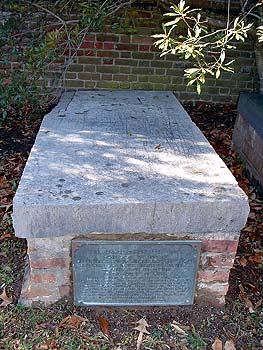
He died December 20, 1723 and was buried on the grounds of Ware Parish. His tombstone reads as follows:
“[Her]e lyeth the Body of [Jame]s Clack son of William and Mary Clack [who wa]s born in the Parish of Marden ***** Miles from the Devizes [In] the county of Wilts [He] came out of England in August [16]78, Arrived in Virginia upon New Years day following came into the Parish of Ware [on] Easter Where he continued Minister near forty five years till he Dyed He departed this life on the 20th day of December in the year of our Lord God 1723 in hopes of a joyful Resurection to Eternal Life which God grant him for his Blessed Redeemer’s Sake, Amen.”
Christopher Branch
“Christopher Branch, Sr. was born 02 Sep 1598 in Greater London, England, the only son of Lionel Branch (1566-1605) and his wife, Valentia Sparke
Christopher was married at St. Peter’s, Westcheap, London, in the city of London by virtue of a marriage license from the Bishop of London on 02 Sept 1619 to Mary Addie (Addy), daughter of Francis Addie (Addy), husbandman of Darton, Yorkshire. Christopher’s notice of his intent to marry Mary Addie was posted at St. Peter’s Westcheap, London in 1619. Christopher must have been well thought of by his grandfather, William Branch, for he left him 5 marks in his will. Christopher’s father, Lionel, was disinherited in the same will.
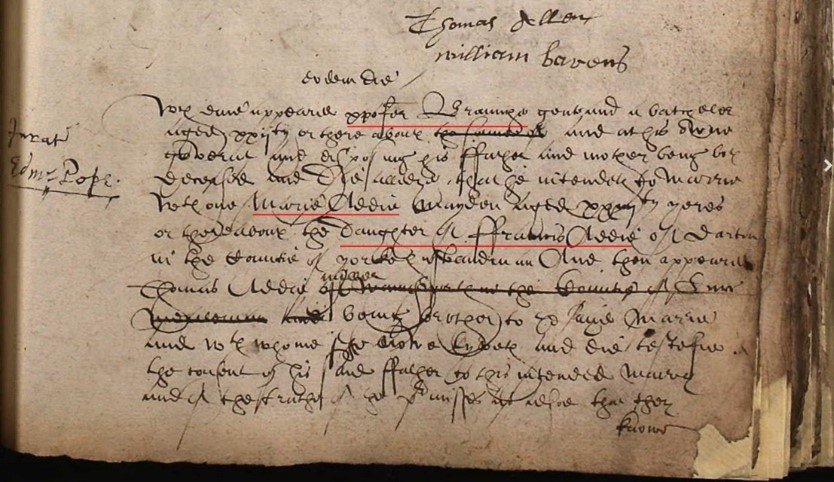
In March 1620, Christopher and Mary (Addie) Branch embarked on the “London Merchant” of 300 tons burden dispatched from the Port of London for Virginia. This ship was commissioned by the Virginia Company and carried 200 passengers, mostly single men, and arrived with only the loss of one soul. Christopher and Mary first settled in present Henrico Co., in an area called “ye Colledg Land” (the College Land) circa 1623/24 and in the muster, 1624/25, he, his wife and their 9-month-old son, Thomas, were listed there. The Virginia Company offered inducements for new colonists to settle on the College Lands at this time to replenish the population decimated by the recent (1622) Indian massacre. The precise location of the Branch home, during this period, is indeterminate as the College Land was a very extensive tract set aside by the Virginia Company whereon “to erect and build a college in Virginia, for the training and bringing up of infidel’s children to the true knowledge of God and the understanding of righteousness”.
Shortly afterward, Christopher patented land and lived at or near Arrowhattocks on the North side of the James River and finally settled at “Kingsland”, his plantation on the South side of the James River almost opposite Arrowhattocks near Proctor’s Creek. Their son, Thomas, born May, 1624 was listed as the only Virginia born child in the county (Henrico) at the time. “Kingsland”, just west of “Farrar’s Island”, was also near “Osborne”, home of the Jeffersons.
Christopher returned briefly to England in 1632, going to court, proclaiming the Bull Inn in Abingdon ought, by rights, to be his, but of which he had been cheated by his uncle, Robert Payne. He stated in court that his father (Lionel Branch) died 27 years earlier when he himself was only two or three years old. Robert Payne’s son, Richard, was the owner of Bull Inn at the time of the suit. Christopher’s case stated that, by the terms of his great-uncle Thomas’ will of 1565 the Bull Inn after descending to his grandfather, William Branch, and to his uncle, William’s eldest son Thomas, should have descended to Christopher’s father, Lionel, as heir at law of the younger Thomas, and so to Christopher after Lionel’s death.
Land acquisitions of Christopher Branch, Sr.: As “Christopher Branch, Planter, of Arrowhattocks in Henrico County”, he was granted a lease, 29 Oct 1634, for 21 years on 100 acres lying “east upon the maine River (the James)” [Patent Bk.1, p155]. The following year, 08 Dec 1635, he patented 250 acres”at “Kingsland” (his plantation) over against Arrowhattocks, east upon the maine River…. adjacent to the land of John Griffin, now in the tenure of said Branch….50 acres for his own personal adventure and 200 acres for the transportation of 4 persons (head rights) [Patent Bk. 1, p155]. “By 28 Feb 1638/9, Christopher Branch, Sr.’s plantation numbered 450 acres after he had acquired an additional 100 acres through an exchange with James Place (see map below near Kingsland) and the remaining acreage through additional “head rights” [Patent Bk. 1 pp381, 527, 634]. He accumulated a large plantation in the extreme northeast of Chesterfield Co., bounded upon the east by the James River and upon the south by Proctor’s Creek. The present Kingsland Creek ran through his property. He was a prosperous tobacco planter whose land holdings grew to 1,380 acres by the time of his death at the age of 80 (an exceptional age for the times).
An “Item” from the 20 Jun 1678 will of Christopher Branch, Sr. probated 20 Sep 1681/82 in Henrico Co. states, “Item: I give unto Thomas Jefferson (I) (1629-1697), one hogshead of tobacco of four hundred pounds weight whom I made with my grandson Christopher Branch III my full and sole executor of this my last will and testament and I desire him to see my will truly performed, my debts and legacies being paid and burial discharged, all the rest of my estate I give unto my grandchildren Christopher Branch and Samuel and Benjamin and Sarah and Mary Branch, the wife of Thomas Jefferson (this was Thomas Jefferson I (1629-1697), the great grandfather of President Thomas Jefferson) to be equally divided among them. Witness my hand and seal the day and year above written.
Signed: Christopher Branch
Witnessed by: Richard Ward and Abel Gower.
Source: Henrico County Wills 1677-1692.
Christopher Sr. died in 1682 and was buried at “Kingsland”, his plantation, in the Branch Family Cemetery in a now unidentifiable grave site.
Christopher Branch, Sr.’s lineage is proven to Charlemagne through King William I (the Conqueror) and his descendants qualify for membership in the “Jamestowne Society” and the “Order of the Crown of Charlemagne in the United States of America.”
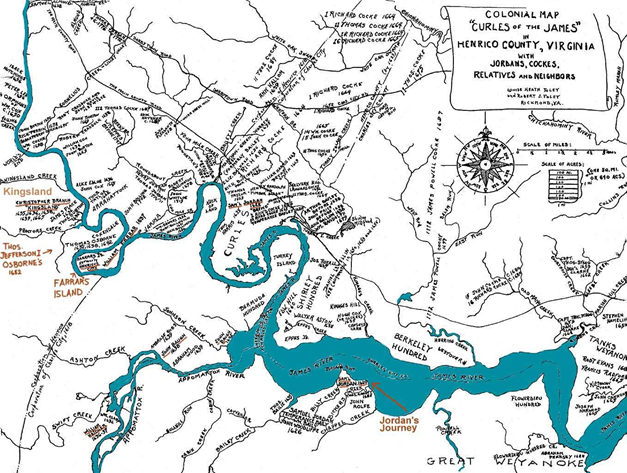
Nathaniel Basse
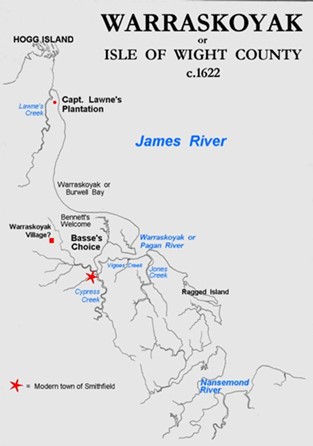
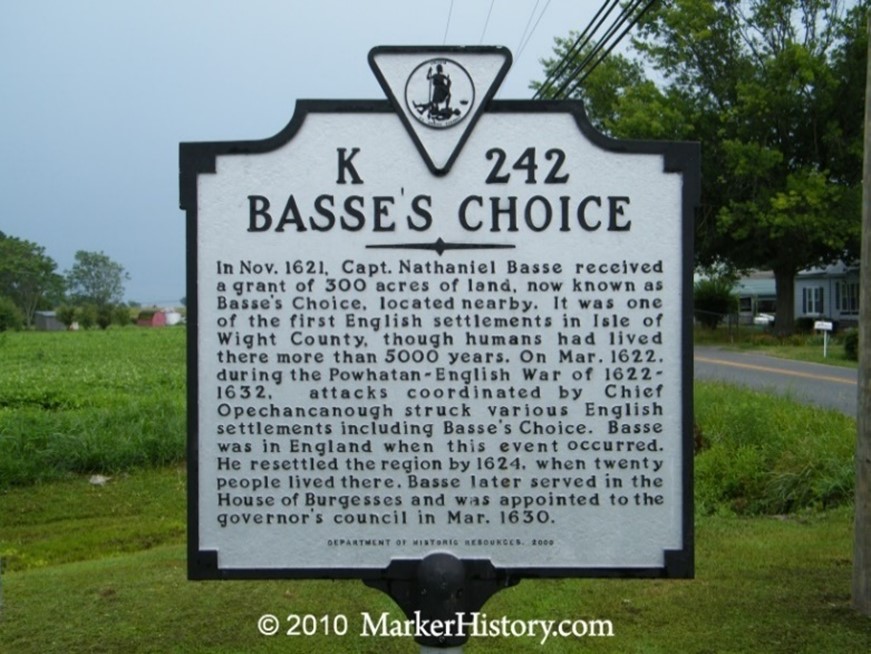
Basse’s Choice Plantation
Nathaniel Bass was baptized 29 Dec 1589, at the Church of St. Gabriel, Fenchurch Street, London, Middlesex, England. Basse was the second of twelve sons and second of eighteen children of Humphrey Basse and Mary Buschier Basse. His mother was of French and Italian descent, and his father was a prosperous London girdler of French ancestry who invested in the Virginia Company of London. “Nathaniell Basse and Mary Jordan was married ye 21 day of May in ye year of our blessed Lord and Saviour 1613.” (Family Bible Records)
The first English settlement in the area known by the Indians as Warrosquoyacke (Isle of Wight Co., Virginia) was made by Captain Christoper Lawne, Sir Richard Worsley, Knight & Baronet, and their associates Nathaniel Basse, Gentleman, John Hobson, Gentleman, Anthony Olevan, Richard Wiseman, Robert Newland, Robert Gyner and William Willis.
They arrived at Jamestown with one hundred settlers on 27 April 1619 in the ship “Furtherance” commanded by Captain Evans. They immediately settled on the south side of the Warrosquoake River (James River) and established the plantation “Warrosquoake”, to be known as “Lawne’s Creek”. When their patent was confirmed, it was to become known as the “County of Isle of Wight”.
Nathaniel Basse and others undertook to establish another plantation in the same neighborhood, to the east, known as “Basse’s Choice,” situated on the Warrosquoake River (James River) and Pagan Creek. His patent was received 21 Nov 1621 for 300 acres plus 100 acres of marshland. The houses on Captain Basse’s plantation were being built when at midday on Good Friday, 22 Mar 1622, the Indians attacked the settlers killing 347 of the 1240 English inhabitants in the 80 settlements on the north and south sides of the river (James). 26 at Isle of Wight were among those killed. The settlers made a valiant defense of themselves with guns, axes, spades and brickbats. It is thought that Nathaniel and his wife, Mary, were in England at the time, and some of the children were at “Basse’s Choice” with a nurse. The story is told that five-year old John was one of the children that escaped and was rescued by some friendly Nansemond Indians! His older brother Humphrey died that day. A 1622 passenger list for the ship “Furtherance,” from London, arrived in Virginia, lists Nathaniell Basse, age 35. Many ships at that time considered passengers as cargo and did not list their names. Some ships listed the names of the men on board but did not list women and children.
A census taken 16 Feb 1623 shows a total of 53 persons living at “Worwicke-Squeak,” and “Basse’s Choice”. Nathaniel Basse and Samuell Basse were among those listed. Capt. Nathaniel Basse, Samuel Basse and William Basse are also found living among the list of 1,033 early Pioneers of 1624. They are listed as living at Basse Choise.
Nathaniel was appointed to the House of Burgesses at the first Legislative Assembly representing Warrosquoake (Isle of Wight) for 1623. He was again a member of the House of Burgesses in Oct 1629 and 1631, appointed to Harvey’s Council 1631 and a member of the Great Council 1631. On 6 Mar 1631 Nathaniel was commissioned to “trade between 34 and 40 N Latitude, England, Nova Scotia and West Indies to invite inhabitants hither”. Nathaniel was also commissioned to trade to the Dutch Plantation and Canada. He was given power of Justice of Peace. (Virginia Council & General Court Records 1626-1634)
Basse’s Choice originally called for 300 acres, but its acreage was closer to 400. Mr. Peter Knight married to Nathaniel’s daughter Genevieve, patented 150 acres of the same in 1640 and 255 acres in 1643. Peter Knight sold the tract to John Bland, an eminent London Merchant.
Nathaniel Basse was buried 3 July 1654 in the Church of St. Alphage, Cripplegate, London. Mary, his wife, had died 17 Jan 1630, with the birth of a stillborn son. After Nathaniel’s death in 1654, the General Assembly of Virginia in 1659 ordered Mr. Wm. Drummond as agent of the Co-heirs of Nathaniel Basse to pay to Theodorick Bland of Westover, 2500 lbs tobacco in settlement of a suit affecting the land.
Heather and I are both descended from Nathaniel – making us 11th cousins once removed.
Onesiphorus Harvey
“The earliest Hervey / Harvey that we know if is Onesiphorus Harvey who we find living in Lancaster County, Virginia by 1702. The family followed a very normal pattern of migration from Virginia to North Carolina and then after the American Revolution to Tennessee and on to Texas. (ancestor of Anne Hervey, married Moses S. Townsend, Sr.)
The following excerpts are from “Colonial Virginia and The People of the Northern Neck” By Donald G. & Joyce P. Hervey:
“Hervey family roots are buried deep in the Northern Neck of Colonial Virginia. By the late 1600’s the ancestors of our Hervey family were well established in Northumberland County. In order to understand the forces that attracted this family to America, or perhaps drove them here, we have prepared the following account of the beginnings of modern civilization in that part of the New World known as Virginia.
In a scholarly article by John E. Manahan, PhD, in the Bulletin of Northumberland Co. Historical Soc., he examined the politics of the first families that settled in Northumberland County. Mr. Manahan took a list of names of 101 men who signed a document known as the “Northumberland Oath” and compared the names with known Royalist (followers of the King) or Roundhead (followers of Cromwell) families in England and in Virginia. The document, which stated, “Wee whose names are subscribed doe promise and Ingage ourselves to be true and faithful to the Commonwealth of England as it is now established without King or house of Lordes, Signed April 13, 1652 at Coan”, was a pledge of allegiance to Cromwell’s Parliament in England. The signers of the Oath represented both Royalists and Roundheads. Obviously, some of the signers had political leanings which belied their confessed allegiance to the Commonwealth (or could they have changed their allegiance?).
In England, Catholics were usually Royalists; whereas, in America, many Catholics had become disenchanted with the rule of the Lords Baltimore in Maryland and fled to Virginia, either switching their allegiance from the Crown of England to the Usurper (Cromwell), or at least becoming more sympathetic to his cause.
Mr. Manahan theorized that Puritans and Catholics on the rebound from Lord Baltimore’s rule in Maryland were the first group to come to Northumberland and settle on the Coan river. As the 1650’s progressed many of the King’s men from England fled the Commonwealth and went to Northumberland, thus making an interesting mixture of Royalist and Roundhead in the area.
The first land grant issued in Northumberland County was to Richard Thompson, Jr. on April 5, 1649, for land on Wiokocomoke Creek. There followed grants to many English gentlemen whose family surnames appeared on lists of known Royalists published in England. On these Royalists lists appeared many names, such as John Harvey of Suffolk, that were familiar to the Northumberland ear.
Of the two parishes in Northumberland, St. Stephens, the larger and northern parish, was more Roundhead in politics than the parish of Wicomico. Mr. Manahan listed names of Northumberland families that he classified as clearly Roundhead or Puritan. Among this list appeared the names of Onesiphorus Harvey (ancestor) and Onesiphorus Dameron. In his list of leading families of Northumberland before the Revolution, Mr. Manahan included these names: Gaskinses, Damerons, Mahanes, Steptoes, Taylors, Heaths, Edwardses, Smiths, Coppedges, Nutts, Hudnalls, Jameses, Waddeys, Prichards, Tignors, Hughletts, Webbs, Coleses, and many others. The ones listed above are familiar family names of persons who have inter-married with or been closely connected to the Hervey/Harvey family throughout its history and movement of the family from Virginia to North Carolina, Tennessee, and ultimately to Texas.”
Abner and John Houston
Immigrants to Jamestown in 1616 (ancestors of Rebecca Harper who married Asa Townsend)
John Houston Sr was born 01 Jun 1611 in Scotland. He died abt 1671 in PA. (Probably Philadelphia, Philadelphia Co, PA) He married Margaret Hathaway 03 May 1638 in Jamestown, James City Co. VA Margaret was born about 1616 in Scotland.
“John with his family of 4 sons and 2 daughters, and seven young men immigrated, May 4, 1654, to a point of the Delaware River, a few miles above where the town of Philadelphia was afterward located. There they cleared several farms and established a trade with the Indians.”
“When William Penn arrived there in 1681 with a grant from King James for the territory now called Pennsylvania, he employed John Houston as an assistant in surveying the land, laying it off in sections or counties. He also assisted in laying out the site which Penn named Philadelphia, having named the grant Pennsylvania.”
“John Houston was one of the first to build a log residence at the site of the birthplace of the city.” Here Alfred leaves the lineage of his nephew, John Houston, and his family. John probably died in Philadelphia, PA.
John’s father was Abner Huston, See notes about names changes under Alfred Houston. Abner sailed for Jamestown, September 3, 1616, but owing to a boisterous sea, did not reach his destined port until October 20, 1616. Before he left Wales, there had been born to him three sons, Joseph, born October 9, 1609; John, born June 01, 1611; and Samuel, born Sept 13, 1613. Alfred and brother Abner married twin sisters (daughters of Welch Sconce, a merchant of Aberdeen). Alfred married Ruth. Abner married Rachel.
The 1st legislative body to meet on American soil met at Jamestown, July 1619. Among the delegation were Alfred Houston and Abner Huston.
Alfred held the Position in the Academy as Professor of Philosophy and Mathematics. About this time the Reformation had given rise to violent religious controversy, and the two brothers decided to change their surname. Accordingly, Alfred proposed to write their name Houston, but Abner thought there was in this spelling too much of the sound of House, and proposed Huston, as further removed from the original, and more phonetic. Before they agreed upon this change of their name, Alfred resolved to emigrate to America. Accordingly, on the 12th of April 1612, he and his wife and one child, with several other families, embarked for the new world.
After a voyage of 28 days they landed at Jamestown, on the James River, and cast their lots with the “London Colony,” which had been established in 1607, by the famous Captain Smith, whose life had been saved by Pocahontas. Abner, his brother, who remained in the old world, emigrated from Dublin to Wales, located in Corwon on the River Dee, where he engaged in his favorite calling, merchandising.
There being no preacher of the “John Knox doctrine” in the London Colony, upon the arrival of Alfred at Jamestown, he was employed to preach the new doctrine to the colonists. He soon became popular both as a colonist and as a preacher, though a “Knoxite” and differing with many of the colonists in religious faith.
Four years after Alfred located at Jamestown he wrote to his brother Abner, giving him a glowing account of the new world, and insisting that he should emigrate and join him at Jamestown, and subscribed his name to the letter, Alfred Houston. Abner accepted the invitation to emigrate to Jamestown, and wrote to his brother accordingly, to his letter signing his name Abner Huston, showing that each of the brothers had adhered to his preference of a new spelling of their names. As the different spelling had become interwoven with their business and they had so spelled their names in the family records, they concluded, after they met at Jamestown, that each family should retain the spelling respectively adopted.
Vann Ancestors
The Vann’s descend from Sir Henry Vane, a courtier of King Charles and a Member of Parliament. He married the daughter of the Italian ambassador to England. Sir Henry’s grandson sailed to the New World and became a colonial Virginia planter.
The Vann ancestry begins with Sir Henry Vane, an aristocrat and courtier of King Charles I. He married the daughter of a British diplomat who had married into a well-known Florentine family. One of his ancestors was a Papal counselor and tutor of Nicolo Machiavelli. Henry’s son served in the military during the Dutch wars, and his grandson migrated to the Virginia colony. In later generations the Vann family moved to North Carolina, then to Tennessee, and then finally in the mid-1800’s, to Texas.
Henry Vane the Elder
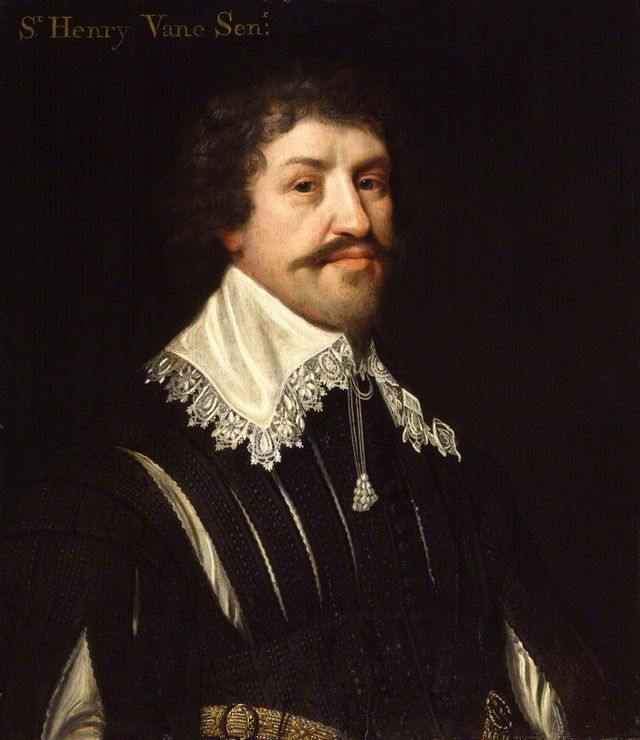
possibly after Michiel Jansz. van Miereveldt
oil on panel, circa 1642
Sir Henry Vane, the elder (18 February 1589 – 1655) was an English politician who sat in the House of Commons at various times between 1614 and 1654. He served King Charles in many posts including secretary of state, but on the outbreak of the English Civil War joined the Parliamentary cause.
Vane was the eldest son of Henry Vane or Fane of Hadlow, Kent, by his second wife, Margaret, daughter of Roger Twysden of East Peckham, Kent. He matriculated from Brasenose College, Oxford, on 15 June 1604, was admitted a student of Gray’s Inn in 1606. He was knighted by James I on 3 March 1611.
At the age of twenty-three, he married Frances Darcy, daughter of Thomas Darcy of Tolleshurst Darcy, Essex. Immediately after his marriage, writes Vane in an autobiographical sketch, ‘I put myself into court, and bought a carver’s place by means of the friendship of Sir Thomas Overbury, which cost me £5,000.’ Next year he devoted the £3,000 of his wife’s portion to purchasing from Sir Edward Gorges a third part of the subpoena office in chancery, and later so ingratiated himself with the king that James gave him the reversion of the whole office for forty years. In 1617 Sir David Foulis sold him the post of cofferer to the Prince of Wales, and he continued to hold this office after Charles had become king. In about 1629 he became Comptroller of the household in place of John, first baron Savile. Finally, in September 1639 he was made Treasurer of the Household.
In February and again in September 1629, and in 1630, King Charles sent Vane to Holland in the hope of negotiating a peace between the United Provinces and Spain, and obtaining the restoration of the Elector of the Palatinate by Spanish means. In September 1631 Vane was sent to Germany to negotiate with Gustavus Aldophus of Sweden As King Charles merely offered the king ofSweden £10,000 per month and expected him to pledge himself to restore the palatinate. Gustavus rejected the proposed alliance. Vane’s negotiations were also hindered by a personal quarrel with Gustavus, but he gave great satisfaction to his own master. Cottington wrote to Vane “Through your wise and dexterous carriage of that great business, you have saved his majesty’s money and his honour”.
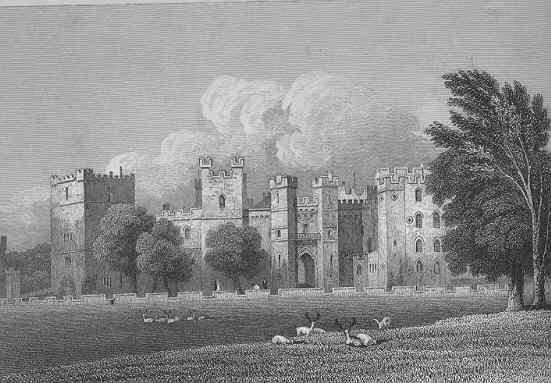
He had sold his ancestral estate of Hadlow, and bought in its place Fairlawn in Kent at a cost of about £4,000. He also purchased the seignories (lordship) of Raby Castle, Barnard Castle and Long Newton in County Durham, at a cost of about £18,000.
On 3 February 1640 the king, to the general surprise, appointed Vane secretary of state in place of Sir John Coke. Vane sat in the Rump Parliament after Pride’s Purge in December 1648.
Vane died at the age of about 66 in or around May 1655. Royalists reported that he had committed suicide, through remorse for his share in Strafford’s death. His widow, Frances, Lady Vane, died on 2 August 1663, aged 72, and was buried at Shipbourne, Kent.
Two of his sons, William (Ancestor) and Walter, were soldiers in the Dutch service. Walter, who was knighted, seems to have been royalist in his sympathies, and a large number of intercepted letters from him to friends in England are printed in the Thurloe Papers.’ In 1665 Charles II employed him as envoy to the elector of Brandenburg. Vane was colonel of a Regiment of Foot in the English service in 1667, and on 12 August 1668 was appointed colonel of what was known as the Holland Regiment. He was killed serving under the Prince of Orange at the Battle of Seneffe in August 1674, and was buried at The Hague.
First Virginia Vanns
John Edward Vann (1634-1667) (Grandson of Sir Henry Vane). John Edward was transported into Virginia by 1666, as evidenced by a land patent in Accomack Co VA. Edward Vann patented 250 acres on southern branch of Nansemond River Isle of Wight Co. Va. 9 Apr 1662.
The first extant record of land grant to a Vann in Virginia is 14 Dec.1714. For William Vann (1655-1740) 130 acres in a place called ‘Starrum’ in Nansemond Co, Virginia, for importing three persons.
He is thought to be the one who moved into the old Chowan Precinct of North Carolina where he received Patent #90.
William Vann made his will in Chowan Precinct 16 April 1735, in which he named wife Sarah, “my loving wife Sarah all remainder of my estate” daughters Sarah Hogh, Ann Vann, son Edward (Ancestor), and grandson William (Ancestor), son of Edward. He lent his land to son Edward “my plantation I live on” for life, then to grandson William.
New England Colonial Immigrants
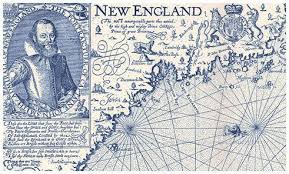
Fisher Ancestors:
Almira Mann married the German immigrant George Lewis Fisher. Her ancestors were Irish and English who came to the New World in the 1600s.
Richard Mann
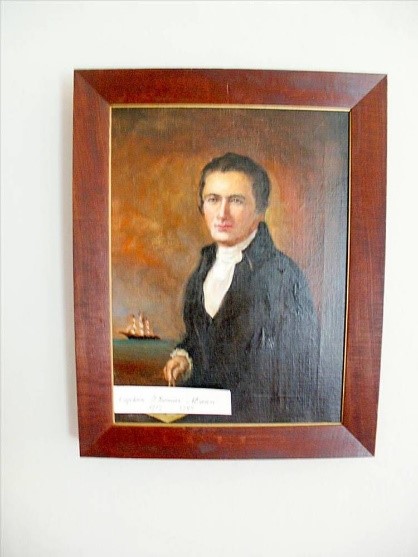
Richard Mann was born about 1609 in England and died in Feb 1654/55 in Scituate, Plymouth, MA about age 46.
Richard Mann, of Scituate was one of the first bearing the name who, probably with wife Rebecca during the reign of King Charles I of England, emigrated from that country no doubt a few years previous to 1644. The first appearance of his name on record is found with thirty-one other persons in the town of Scituate as having taken the “Oath of Fidelity.” This act dated 15 Jan 1644. Richard was a farmer, and one of the original land proprietors. His foresight, no doubt, led him to select one of the most beautiful locations for a residence on the coast. His neighbor on the south was John Hoar, who early removed to Concord, Mass. On the east of him was the sea; north “Musquascut Pond”; still further north and bordering the “Pond” were the “Farmes” so-called. In an attempt to cross this pond in Feb 1655 on the “iyce”, he was drowned. Like most of the earliest settlers, he has no monument to mark his grave. It appears he was a man of some note, and much respected in the Colony. Among his descendants may be found many in the various professions, trades, etc. A great proportion, however, have been and are farmers. His widow petitioned the court 5 Mar 16 55, to administer his estate. He was one of the Conihassett partners in Scituate, 1646. His farm was at Mann Hill. There is no record of his marriage here. His children born in Scituate were Nathaniel; Thomas; Richard; and Josiah.
RICHARD MANN’S INVENTORY:
“An Inventory of the houses lands and Chattles and goods of Richard Mann of Scituate ” was taken 14 April 1655, by James Cudworth and Walter Briggs, and was sworn to, before Timothy Hatherly, 6 May 1656. The real estate was: “one Dwelling house & barne with 43 Acars of upland 13 Acars of marshland and one share of Connahasett land, 2 oxen, 1 heifer, 2 steer s, 3 yearlings, 3 bu. barley, 36 bu. wheat, 1 pair shoes, 1 bu. malt, 1 bed, 2 old blankets, 1 rugg, 1 warming pan, 2 spinning wheels, 1 iron kittle, 1 iron pot, 1 iron skillet, 2 frying pans, 1 little kittle, 1 skillet, 1 pr. of tongues, 1 cradle, 2 old pitchforks, & pr. cards, a bible & other books, 1 plow, 2 ax, 2 hammers & how, 2 pieces bacon, small shot gun, 4 old chairs, & pr. of ballences, 1 Sabbath shorth coat. (All valued at about $75.). May 6, 1656, Rebecca Man, wife of Richard Man, decease d, doth give her 3 youngest children to each of them 5 pounds. Cap. Cudworth standeth bound to the same performed out of the estate of sd. Richard Man.” (Plymouth Colony Records)
“Capt: James Cudworth hath engaged to save the court from an Damage that may come to it by the adminnestration graunted to the wife of Richard Man Deceased.”
The Plymouth Colony records show that Richard Man was drowned early in 1656 and that his widow married John Cowin of Scituate.
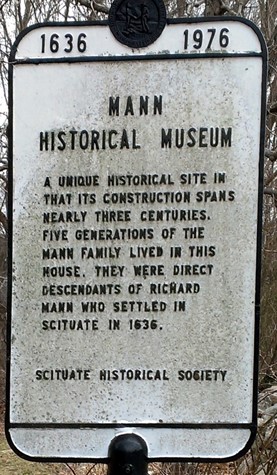
The Mann Farmhouse and Historical Museum is a unique historical property in that its construction spans nearly three centuries. It is at 108 Greenfield Lane, Scituate, MA and open to the public. In the cellar may be seen the original foundation of field stones which dates back to the late 1600’s. The main house that now stands was built during the latter 1700’s on the original foundation. It is a typical full Cape with a large central chimney. The wing was added in 1825 and served as a summer kitchen, storage area and workshop.
Five generations of the Mann Family lived in this house. They were direct descendants of Richard Mann who came to Scituate in 1636. His home was near Musquashicut Pond, and it is from him that Mann Hill derived its name. Percy Mann, the seventh and last direct descendent of Richard Mann, lived in this house until 1968 and died at the age of 93.
The artifacts of the Mann Family on display in the Mann Farmhouse, date from the seventeenth century to the present time and were given to the Town of Scituate under the custody and administration of the Scituate Historical Society by two of the Mann Family heirs. They include primitive tools, military items, china, children’s toys, early farming equipment and many valuable documents and books. The Manns worked at many trades: they were farmers, sea captains, soldiers in every war; ministers, teachers, and sail makers.
The grounds of three and a half acres are also being restored by the Scituate Garden Club. The famous crocus bed which stretches under the trees behind the stone wall is visited every spring by hundreds of people from far and wide. [Pamphlet of the Scituate Historical Society]
Thomas Wheeler
Thomas Wheeler (c.1620, England – December 16, 1686, Concord, Massachusetts) was a colonial soldier of the Massachusetts Bay Colony. In 1675 he took part in King Philip’s War; later he wrote a narrative based on his experiences.
He emigrated from England to the North American colonies in 1642. In 1644, he was living in Fairfield, Connecticut. In the 1650s-Wheeler was a trader; in 1657 he purchased the right to trade with the Native American tribes for twenty-five pounds. Around 1661 he was one of the first people to purchase land in the Ockocangansett plantation, which later became the town of Middleborough, Massachusetts. He was made a lieutenant on October 12, 1669, and a captain in 1671.
In 1675 he took part in King Philip’s War against the Wampanoag and Nipmuck tribes. At the beginning of the hostilities, he was assigned as military escort to Cpt. Edward Hutchinson and together with him, led his men into an ambush, carried out by the Nipmucks under Muttawmp and Matoonas, at Brookfield, Massachusetts, that has become known as Wheeler’s Surprise. His horse was shot out from under him, and he was seriously wounded, but eventually survived the battle. His son, also named Thomas Wheeler was also wounded, in the loins and arm, but also managed to survive.
Thomas Wheeler (senior) eventually wrote an account of the engagement, which was first published in 1676 by Samuel Green, under the title “A Thankfulle Remembrence of Gods Mercy. To several Persons at Quabaug or BROOKFIELD”. Wheeler’s work exemplifies the Puritan conception of heroism, in which a person’s piety is their virtue while the credit for the victory in battle is ascribed to God.
He died in 1686 due to complications from the wounds received at the battle of Brookfield.
The Wheeler-Merriam House (or “Elm Brook Farm”) is an historic house at 477 Virginia Road in Concord, Massachusetts. The house was built in 1692 and was added to the National Register of Historic Places in 1982.
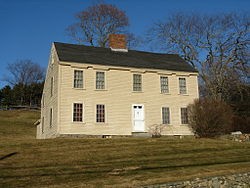
Earley – Price Ancestors
Obadiah Holmes
He was christened at Didsbury, Lancashire on Mar 18, 1609/10, the son of Robert Hulme Jr and Catherine (Johnson) Hulme. He married Catherine Hyde on 20 Nov 1630 at Manchester, Lancashire, England. His stone suggests a birth as early as 1606, and, In 1675, he wrote a letter, I Obediah Hullme … sixty nine years old or thereabouts (NEHGR 67:23).
Upon arriving in America he was admitted to membership in The Church of England in Salem, MA. On Mar 24, 1639, he established a glass foundry, the first in America to make window glass. However, he became a victim of religious persecution, was excommunicated from the church at Salem, and in 1646 moved his family from Salem to Rehoboth, MA. On Oct 2, 1650, Obadiah Holmes and others of Rehoboth, were indicted by the Grand Jury at New Plymouth for holding meetings in their homes on Sunday. This indictment prompted his move from MA to Newport, RI. There he became a colleague of Roger Williams, and the 2nd minister of the first Baptist Church in Newport, RI, taking the leadership of the church while Pastor John Clarke, M.D. was England.
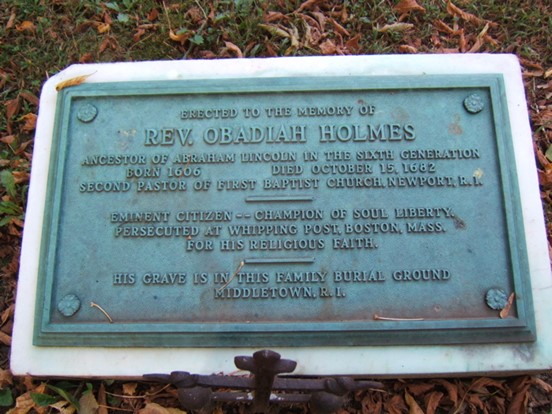
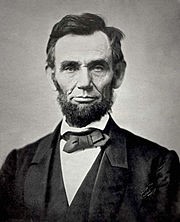
Abraham Lincoln was a prominent descendant of Obadiah Holmes.
William Salmon
William was born 1610 in Nazeing, Essex, England and immigrated to North America 21 May 1635 from England to St. Christopher, and soon after settled at a place known as Hashamomuck and Nashayonsuck that he bought from a Amahansuch Indian named Pauhamp, with his son Ambuscow, agreeing to it. Hashamomuck, Long Island is near Southhold, Suffolk, Long Island, New York. We find that William Salmon aged 25, left England 21 May 1635 in the Matahew of London. In the same book is listed the fact that Peter Salmon, age 20, sailed for St. Christopher 13 Oct 1635; he may have been a younger brother to William.
William was the member of a group from the Summer Isles (Bermuda) who went adventuring in 1636 to the Chowan (Indian) country (North Carolina) for spirits resin (turpentine). There they met Matthew Sinderland, a Mariner from Boston Massachusetts. Salmon and some of his associates threw in with Sinderland and returned with him to Long Island.
William Salmon acquired a home lot in Southold, Long Island where he plied his Blacksmith trade … Sinderland, who was married to Cathrine Curtice, … died intestate and childless about 1642 … William Salmon married the widow Kathrine soon thereafter, about 1643, and moved in with her at Hashamomuck, now part of Long Island, New York. He died 13 May 1657 in Southold, Long Island, New York.
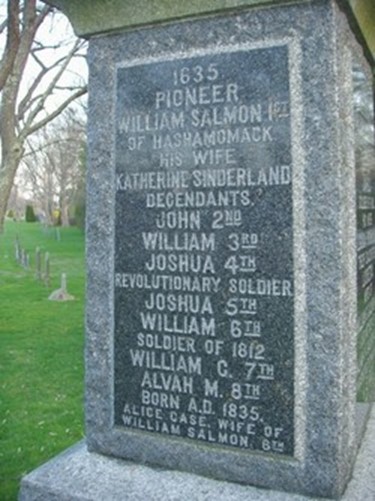
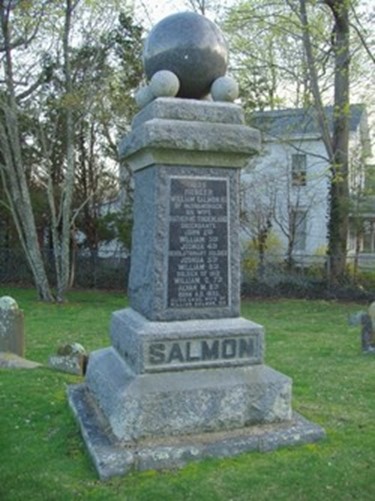
Burial: Old Burying Ground of First Presbyterian Church Southold, Suffolk County, New York,